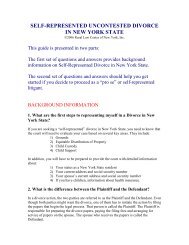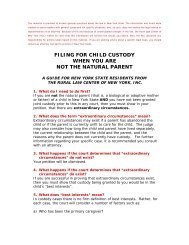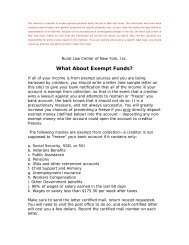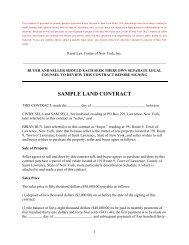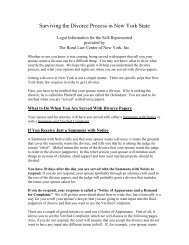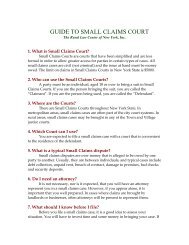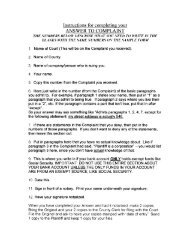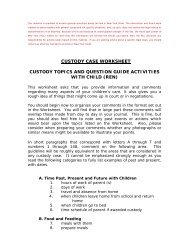self-represented uncontested divorce in new york state - Rural Law ...
self-represented uncontested divorce in new york state - Rural Law ...
self-represented uncontested divorce in new york state - Rural Law ...
Create successful ePaper yourself
Turn your PDF publications into a flip-book with our unique Google optimized e-Paper software.
SELF-REPRESENTED UNCONTESTED DIVORCEIN NEW YORK STATE©2006 <strong>Rural</strong> <strong>Law</strong> Center of New York, Inc.This guide is presented <strong>in</strong> two parts:The first set of questions and answers provides background<strong>in</strong>formation on Self-Represented Divorce <strong>in</strong> New York State.The second set of questions and answers should help you getstarted if you decide to proceed as a “pro se” or <strong>self</strong>-<strong>represented</strong>litigant.BACKGROUND INFORMATION1. What are the first steps to represent<strong>in</strong>g my<strong>self</strong> <strong>in</strong> a Divorce <strong>in</strong> NewYork State?If you are seek<strong>in</strong>g a “<strong>self</strong>-<strong>represented</strong>” <strong>divorce</strong> <strong>in</strong> New York State, you need to know thatthe court will need to evaluate your case based on several key areas. They <strong>in</strong>clude:1) Grounds2) Equitable Distribution of Property3) Child Custody4) Child SupportIn addition, you will have to be prepared to provide the court with detailed <strong>in</strong>formationabout:1) Your status as a New York State resident2) Your current address and social security number3) Your spouse’s current address and social security number4) If you have children, <strong>in</strong>formation about health <strong>in</strong>surance.2. What is the difference between the Pla<strong>in</strong>tiff and the Defendant?In a <strong>divorce</strong> action, the two parties are referred to as the Pla<strong>in</strong>tiff and the Defendant. Eventhough both parties might want the <strong>divorce</strong>, one of them has to <strong>in</strong>itiate the action by fil<strong>in</strong>gthe papers that beg<strong>in</strong> the legal process. That person is called the Pla<strong>in</strong>tiff. The Pla<strong>in</strong>tiff isresponsible for prepar<strong>in</strong>g the <strong>divorce</strong> papers, pay<strong>in</strong>g the fil<strong>in</strong>g fees and arrang<strong>in</strong>g forservice of papers on the spouse. The spouse who receives the papers is called theDefendant.
3. What are “Grounds”?In New York State, “Grounds for Divorce” is the term that is used <strong>in</strong> Matrimonial <strong>Law</strong> tospecify the court-accepted reasons to grant a <strong>divorce</strong>. You must sufficiently meet therequirements for one of the acceptable reasons.4. What are the different types of “Grounds”?In New York State, the acceptable Grounds for Divorce are:1) Abandonment2) Cruel and Inhuman Treatment3) Adultery4) Conf<strong>in</strong>ement to Prison5) Liv<strong>in</strong>g pursuant to a Separation Agreement for one yearWhat is important to understand is that <strong>in</strong> order to qualify for any one of these, yourcircumstances must meet specific requirements.5. Which “Ground” can I choose?The follow<strong>in</strong>g is a list of each type of Ground and a description of how each must beused. Read them over carefully to make sure your situation meets the requirements.Acceptable “grounds” are required. Simply not want<strong>in</strong>g to be married any longer is notsufficient.ABANDONMENTThe ground of Abandonment requires that one spouse leaves the other with no <strong>in</strong>tent toreturn. This must be without the consent of the other spouse and without justification.Additionally, this must have occurred at least one year prior to the fil<strong>in</strong>g of the <strong>divorce</strong>.NOTE: There is an additional term called “constructive abandonment”. This can be onespouse’s refusal to have sexual relations without both spouses agree<strong>in</strong>g. It can also beappropriate if one spouse is forced to leave because of the other’s abusive behavior. Ineither case, this choice of Ground, will require fuller documentation <strong>in</strong> your papers.CRUEL AND INHUMAN TREATMENTIf you are alleg<strong>in</strong>g Cruel and Inhuman Treatment as Grounds, you must be able to provea pattern of behavior that endangers your well-be<strong>in</strong>g and makes it unsafe or unhealthy foryou to cont<strong>in</strong>ue liv<strong>in</strong>g with your spouse. You will need to be able to provide substantialevidence of cruel and <strong>in</strong>human treatment. You can do this by fully describ<strong>in</strong>g yourspouse’s cont<strong>in</strong>ued behavior toward you. Be sure to <strong>in</strong>clude dates or time periods whendescrib<strong>in</strong>g <strong>in</strong>cidents. F<strong>in</strong>ally, and this is very important, the actions of your spouse musthave occurred with<strong>in</strong> 5 years of your fil<strong>in</strong>g for <strong>divorce</strong>. If more than five years have past,you cannot use Cruel and Inhuman Treatment as Grounds.
ADULTERYUnder the law, adultery is def<strong>in</strong>ed as the commission of a voluntary act of sexual<strong>in</strong>tercourse with someone other that one’s spouse. However, as Grounds for <strong>divorce</strong> <strong>in</strong>New York State, it requires very substantial proof, such as witnesses, photographs, etc.CONFINEMENT TO PRISONIf your spouse is currently <strong>in</strong> prison and has been serv<strong>in</strong>g a term for at least 3 years, youmay use that fact alone as Grounds for <strong>divorce</strong>. Your spouse must still be <strong>in</strong>carcerated atthe time of the fil<strong>in</strong>g of the <strong>divorce</strong>.LIVING PURSUANT TO A SEPARATION AGREEMENT FOR ONE YEARIn the absence of any of the above Grounds, or where both parties wish to enter theprocess without either be<strong>in</strong>g at fault, it is possible for them to enter <strong>in</strong>to a SeparationAgreement that sets forth their <strong>in</strong>tent on all issues that need to be addressed. Once this iswritten, it is then signed, notarized and then generally filed with the County Clerk. If thecouple cont<strong>in</strong>ue to live separate and apart for at least one year, they may then use thatSeparation Agreement and its terms to file for <strong>divorce</strong>.6. What is Equitable Distribution?Equitable Distribution is the term used to describe the required division of the propertybelong<strong>in</strong>g to a married couple and acquired by either or both spouses dur<strong>in</strong>g themarriage. New York State law requires that this property be distributed equally or fairlybetween both parties. If you and your spouse have not agreed to the distribution ofmarital property, the court, after a thorough hear<strong>in</strong>g, will decide what is a fair division ofyour property. There are many th<strong>in</strong>gs that the court will take <strong>in</strong>to consideration <strong>in</strong> mak<strong>in</strong>gthis decision. Some of those <strong>in</strong>clude: the length of the marriage, each spouse’s f<strong>in</strong>ancialsituation and f<strong>in</strong>ancial contributions, and the assets, such as real e<strong>state</strong>, bank accounts andpensions. In addition to marital property, marital debt is also considered <strong>in</strong> assess<strong>in</strong>gequitable distribution. It is important to note here that merely divid<strong>in</strong>g your debts doesnot end your responsibility for those debts to your creditors.If there is significant marital property, such as real e<strong>state</strong> or pensions, to be considered, itis very important that you consult a lawyer. The evaluation of these types of assets is acomplicated process and often requires the work of experts <strong>in</strong> order to secure your rightsand m<strong>in</strong>imize the risks.7. What if I own property separately?There are some types of property that are considered separate and not subject to equitabledistribution. This <strong>in</strong>cludes assets owned before the marriage or <strong>in</strong>herited, as long as thisproperty is kept separate dur<strong>in</strong>g the marriage. This also <strong>in</strong>cludes assets that are the resultof compensation for personal <strong>in</strong>jury. Generally, however, property acquired dur<strong>in</strong>g themarriage but held only <strong>in</strong> one spouse’s name is still considered marital property and notexempt from equitable distribution.
8. What is Ma<strong>in</strong>tenance?Ma<strong>in</strong>tenance is the term for what used to be called “alimony”. Ma<strong>in</strong>tenance is rarelyordered and is usually for a very short period. Instead, the court <strong>in</strong>tends for thearrangements reached through equitable distribution to be sufficient.9. How is the Custody of children determ<strong>in</strong>ed <strong>in</strong> a <strong>divorce</strong>?If the couple has children together and any of those children are under 21 years of age,the issue of custody must be established to the satisfaction of the court. There are manyfactors that the court must consider <strong>in</strong> mak<strong>in</strong>g this determ<strong>in</strong>ation and they all center onwhat is called “the best <strong>in</strong>terests of the child”. When determ<strong>in</strong><strong>in</strong>g that, the court looks at awide range of factors, <strong>in</strong>clud<strong>in</strong>g the child’s age, the home environment, the relationshipwith the parent, and the potential for safety and security. Based on those factors, the courtwill consider the type of custody and visitation arrangement most suitable for thesituation.10. Can we decide on our own what we want as a custody arrangement?When you are both <strong>in</strong> agreement about the terms of custody and the schedul<strong>in</strong>g ofcustodial periods, it is possible for you to enter <strong>in</strong>to a formal written agreement stat<strong>in</strong>gyour wishes. Be aware, though, that the court will look carefully at your agreement tomake sure it meets the factors described above. If you do want to go ahead with anagreement, it is a good idea to contact your local mediation program for assistance. Theywill provide a mediator, tra<strong>in</strong>ed <strong>in</strong> custody/visitation matters, to help you draw up youragreement.11. What if we don’t agree on a custody arrangement?If you want to represent your<strong>self</strong> <strong>in</strong> a <strong>divorce</strong> action and custody matters need to bedeterm<strong>in</strong>ed, the very best th<strong>in</strong>g to do is br<strong>in</strong>g this issue to your local Family Court. Makesure your Family Court case is f<strong>in</strong>ished and you have the judge’s Order before you fileyour <strong>divorce</strong> papers. The reason this is the best way to proceed is that your Family CourtOrder can then be <strong>in</strong>cluded as part of your <strong>divorce</strong>. If you cannot afford to have a lawyerrepresent you <strong>in</strong> Family Court, you may qualify for an attorney at no charge. Check withyour Family Court.12. What will the court do about Child Support?Child Support is awarded by the courts <strong>in</strong> order to provide for the needs of the children.For this reason, the standards are specified by legislation. The <strong>state</strong> provides a chart,which is updated each year, to help calculate what the required amount of support will bebased on the comb<strong>in</strong>ed gross <strong>in</strong>come of the parents. What this means is that the <strong>in</strong>comeof both parties is added together. Then, the appropriate percentage is applied from theChild Support Standards to determ<strong>in</strong>e the amount of Support that will be provided for the
child. Next, based on their respective <strong>in</strong>comes, each party’s contribution is calculated. Beaware, that this amount is not the total obligation for Child Support. The court sets thestandard to meet what it considers the child’s basic needs. Other costs, such as un<strong>in</strong>suredhealth care or education, are also generally divided based on the respective <strong>in</strong>comes.13. That seems very complicated. Can we just make our own agreementabout Child Support?Generally, the answer is no. While it is possible to deviate from the Child SupportStandards, it is a difficult process and generally requires the assistance of an attorney.This is especially important to know, if you are plann<strong>in</strong>g to represent your<strong>self</strong> <strong>in</strong> a<strong>divorce</strong>. The court has very specific requirements and you must comply with them,14. What should I do about Child Support to make the <strong>divorce</strong> processgo more smoothly?The very best way to deal with the issue of Child Support is to take this matter to FamilyCourt before you beg<strong>in</strong> any of the fil<strong>in</strong>gs <strong>in</strong> your <strong>divorce</strong>. If you cannot afford anattorney, you may seek legal assistance through the Child Support Unit of your localDepartment of Social Services. S<strong>in</strong>ce no <strong>divorce</strong> will be granted without the courtweigh<strong>in</strong>g <strong>in</strong> on the matter of Child Support, it will save you much time and energy if youget your Child Support Order before you beg<strong>in</strong> any of your <strong>divorce</strong> fil<strong>in</strong>gs.GETTING STARTED1) How do I beg<strong>in</strong>?You will f<strong>in</strong>d all of the forms and <strong>in</strong>structions that you need to use on the New YorkState Unified Court System website. Go to:http://www.nycourts.gov/litigants/<strong>divorce</strong>/<strong>in</strong>dex.shtmlThe forms are available there <strong>in</strong> either pdf. or Word format.2) The forms and <strong>in</strong>structions look complicated. Can I really do thismy<strong>self</strong>?It depends. The <strong>in</strong>structions provided by the court system are very detailed and cover allpossible situations that might arise. Be sure to read the <strong>in</strong>formation provided about thepossible risks to proceed<strong>in</strong>g without an attorney.3) If I decide to go ahead, is there any way to make it easier?
It is helpful if you break the process down <strong>in</strong>to steps and keep a checklist to make sureyou are do<strong>in</strong>g th<strong>in</strong>gs <strong>in</strong> order.4) What are the steps to my <strong>uncontested</strong> <strong>divorce</strong>?There are several ways to proceed, but a good way to break it down is:STEP ONE:Pr<strong>in</strong>t out the blank forms and the <strong>in</strong>structions. (You can also pick up a copy ofthem at you local courthouse.) You can fill these out <strong>in</strong> pencil and then transferyour answers to clean copies when you have them right.STEP TWO:Put the forms <strong>in</strong> groups accord<strong>in</strong>g to the <strong>in</strong>structions.STEP THREE:Complete and file the first set of forms. Keep all of your file-stamped copies <strong>in</strong> asafe place. You will need them later.STEP FOUR:Arrange for service of paper(s) on your spouse.STEP FIVE:File the Affidavit of Service. Keep a file-stamped copy.STEP SIX:Wait the required time to give your spouse the opportunity to respond.STEP SEVEN:If there is no response from your spouse and the required time has passed, youmay prepare and file your next set of papers accord<strong>in</strong>g to the <strong>in</strong>structions on theNYS Unified Court System website.STEP EIGHT:If your papers were prepared correctly, you will get them back with a Judgment ofDivorce signed by the judge who reviewed your case.STEP NINE:You must make copies accord<strong>in</strong>g to the <strong>in</strong>structions. File them with your f<strong>in</strong>alpapers and then serve your spouse with a certified copy of the Judgment. Thisservice should be done by certified mail with a return receipt to you.5) What is service?Service means giv<strong>in</strong>g a copy of a legal document to the spouse you are divorc<strong>in</strong>g. In thecase of your <strong>divorce</strong>, you must arrange to have your spouse “served” with either theSummons with Notice OR the Summons and Verified Compla<strong>in</strong>t. This provides yourspouse with notice of your <strong>in</strong>tention to seek a <strong>divorce</strong> and gives your spouse theopportunity to respond. IMPORTANT THINGS TO KNOW ABOUT SERVICE:1) You cannot be the one to serve your spouse.2) Your spouse must be served by someone over 18 years of age.3) Service cannot be done on a Sunday.



